
Souvenir Shopping Guide: 14 Made-in-Chile Goods to Bring Home from Santiago
Unlike the late 20th century, when Chile was largely associated with oppressive regime, today's Chile is known primarily for its premium wines and colorful crafts. If you're fortunate to visit the country's capital city Santiago de Chile, you will find yourself spoiled for choice with a variety of local stuff asking to find a place in your luggage en route back home. Indeed, you should try hard and clear some space in the suitcase for the gifts that might be plenty. To find out which exactly, check out this list of 14 gift ideas!
(To visit the venues mentioned in this article, check out these Self-Guided Walking Tours in Santiago)
1. Huaso – Chilean Cowboy - Outfit
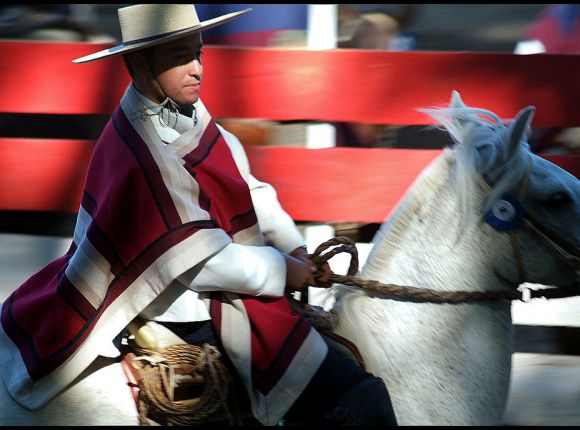
Image Courtesy of: Hector Melo A.
If you are going dance cueca, the national dance of Chile, you must be dressed appropriately. You will need a razor sharp straw hat, a colorful poncho, and a stylish huaso jacket. The black knee-high boots with spurs are also part of the equation. On top of that, the full kit includes traditional huaso riding saddle and a horse. And surely, no cowboy is complete with out a cowgirl, in Chile she is called “Huasa.” The huasa must be dressed in a colorful traditional country dress with ruffles. A basic Huaso outfit starts at about $100 USD. Huasa dresses start at $30 USD.
Where to find it:
An easy place to find traditional huaso and huasa clothing is Catron with four locations:San Diego 1020 (con Avenida Matta)
Phone/fax: 698-9095
Hours: Monday-Friday: 10am-6pm, Saturday: 10am-2pm
Los Cobres de Vitacura
Vitacura 6780 Modulo E Local 5
Phone: 219-2042
Mall Sport
Avenida Las Condes 13.451, Local 210
Phone: 361-1065
Hours: Monday-Sunday: 10am-8pm
Deportes Catron
San Diego 1037 (con Avda. Matta)
Phone: 698-9863
Hours: Monday-Friday: 10am-6pm; Saturday: 10am-2pm
Offline reading and travel directions:
With GPSmyCity App you can read this article offline on your mobile device, use the embedded offline city map and GPS navigation, as well as create a self-guided walk to visit the venues featured in the article.
2. Alpaca

Alpaca is a very fine and soft wool that comes from a smaller relative of the Chilean lama, bred specifically for its fleece. Lama (pronounced in Spanish as "Ya-Ma") is known for being stubborn and also for its ability to spit. The fickle alpaca’s fleece is well adapted to the cold Chilean Andes mountainous climate. Alpaca wool is traditionally used in colorful scarves, ponchos and jackets. The soft Aplaca clothing quickly earned reputation as a favorite winter apparel for locals and visitors alike. Scarves start at $4 USD, Colorful jackets are around $40 to $60 USD, and traditional ponchos start at $50 USD.
Where to find it:
You will find a good selection at the following places:Centro Artesanal Los Dominicos
Avenida Apoquindo 9085, Las Condes
Phone 02-248-2295
Metro station: Los Dominicos
Hours: Daily: 10:30am-8pm
Centro Artesanal Santa Lucia, at the foothills of Cerro Santa Lucia
Alameda 510
Phone 02-632-3668
Metro station: Santa Lucia
Hours: Monday-Friday: 11am-8pm; Saturday: 11am-7pm
Offline reading and travel directions:
With GPSmyCity App you can read this article offline on your mobile device, use the embedded offline city map and GPS navigation, as well as create a self-guided walk to visit the venues featured in the article.
3. Prensado de Flores y Frutas

A nice gift to bring back from Chile can also be trays and kitchenware decorated with thinly sliced and preserved fruits and flowers, which give a unique artistic touch to everyday kitchenware. Oranges, kiwis, lemons, cherries, mushrooms and tomatoes are just some of the fruits and vegetables used in this farm-fresh art form. The latter includes everything, from trays, napkin holders, coasters to bottle holders and even earrings made with real fruit slices! Expect to pay from $10 to $60 USD for trays and most of the art work. A nicely decorated Pisco sour pitcher and matching Pisco glasses sell for about $130 USD.
Where to find it:
There are two good places in Santiago to find Prensado de Flores y Frutas:Arte y Estilo, Local #9 at Patio Bellavista
Dardignac 51, Providencia
Local #6 at Centro Artesanal Los Dominicos
Avenida Apoquindo 9085, Las Condes
Phone: 02-248-2295
Metro station: Los Dominicos
Hours: Monday-Sunday: 10:30am-8pm
Offline reading and travel directions:
With GPSmyCity App you can read this article offline on your mobile device, use the embedded offline city map and GPS navigation, as well as create a self-guided walk to visit the venues featured in the article.
4. Chilean Wine
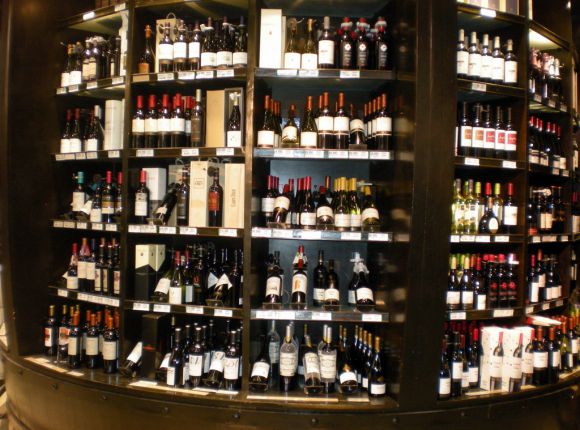
With over 90 wineries, Chile is the 5th largest exporter of wine in the world. The secret to the rise and quality of Chilean wines is the Carménère grape. Thought to be extinct from disease in Europe for over 150 years, it was rediscovered thriving in Chile. Carménère is the deepest, darkest, and purplest of all red grapes, with similar characteristics to Merlot. Initially, it grew as Merlot until was officially recognized in 1998. While Chile produces all the popular varieties of wine - Pinot noir, Merlot, Chardonnay, Sauvignon blanc - Carménère is truly a Chilean wine. Very nice Chilean wines are available for $10 to $20 USD per bottle. If you want a premium or prize winning wine, prices start at $200 USD per bottle.
Where to find it:
The best place to buy Chilean wine in Santiago is as the name states, El Mundo del Vino, they have two locations in Santiago:mall Parque Arauco, Local 379
Las Condes
Phone: 02-580-3548
Hours: Monday-Thursday: 10am-8:30pm;
Friday, Saturday: 10am-9pm; Sunday: 11am-8pm
mall alto Las Condes, Local 2038
Las Condes
Phone: 02-580-3548
Hours: Monday-Thursday, Sunday: 10am-8:30pm;
Friday, Saturday: 10am-9pm; Sunday: 11am-8pm
5. Lapis Lazuli

The lapis stone is considered the master of light. It is the stone of wisdom, friendship, truth, integrity and lighting. Lapis builds relationships of love and friendship, and helps express feelings and emotions. In the Middle East, lapis was even thought to have magical powers. Countless signet rings, scarabs and figures were shaped from the deep blue stone which Alexander the Great brought to Europe. There, the color was referred to as 'ultramarine', which means 'from beyond the sea'. This opaque, deep blue Chilean gemstone has been used by ancient Latin American civilizations for at least 3500 years. Presently, in Chile, it is the national stone. Lapis lazuli is used in key rings, Moai statues, necklaces, earrings and cufflinks. Prices for lapis lazuli depend on the cut and quality of the stone itself and whether it's being used with silver or other precious metals.
Where to find it:
You will find art work made with lapis lazuli at all major shopping areas in Chile. My favorite locations to browse are the three major arts and crafts centers is Santiago:Centro Artesanal Los Dominicos, with 180 shops, it is simply the biggest and the best place to shop in Santiago for Chilean crafts
Avenida Apoquindo 9085, Las Condes
Phone: 02-248-2295
Metro station: Los Dominicos
Hours: Tuesday-Sunday: 10:30am-8pm
Patio Bellavista is a wonderful mix of 20 trendy restaurants and 50 fine crafts shops
Constitución 50, Providencia
Phone: 02-249-8700
Hours: Monday, Tuesday, Sunday: 10am-1am; Wednesday: 10am-2am;
Thursday-Saturday: 10am-3am
Centro Artesanal Santa Lucia, is 150 fine crafts shops in the center of Santiago, at the foothills of Cerro Santa Lucia
Alameda 510
Phone: 02-632-3668
Metro station: Santa Lucia
Hours: Monday-Friday: 11am-8pm; Saturday: 11am-7pm
Buy It on Amazon:
6. Rapanui (Easter Island Moai Miniature Statues)
.jpg)
Image Courtesy of: Ik T
Easter Island is the remotest inhabited place on Earth, and it has been part of the Chilean heritage since 1888. The Moai represent ancestral chiefs who were believed to be descended directly from gods and whose supernatural powers could be harnessed for the benefit of humanity. The massive stone figures were generally erected facing inland to keep watch over the local community. The Moai are characterized by long sloping noses, strong brows, deeply inset eyes, and prominent chins. Some figures also wear a hat-like cylinder made of red stone on their heads. While the original moai are made from volcanic rock, gift moais’ are made from copper, wood, lapis lazuli and many other beautiful stones. Key-rings with Moai figurines start around $2 USD. If contemplating a life-size Moai statue, be careful with your weight limit while traveling, original Moai’s weight over 10 metric tons.
Where to find it:
The best place to buy a Moai statue is on Easter Island itself, however in Santiago I recommend the following Arts and crafts markets:Patio Bellavista is a wonderful mix of 20 trendy restaurants and 50 fine crafts shops
Constitución 50, Providencia
Phone: 02-249-8700
Hours: Monday, Tuesday, Sunday: 10am-1pm; Wednesday: 10am-2am;
Thursday-Saturday: 10am-3am
Centro Artesanal Los Dominicos
Avenida Apoquindo 9085, Las Condes
Phone: 02-248-2295
Metro station: Los Dominicos
Hours: Monday-Sunday: 10:30am-8pm
Centro Artesanal Santa Lucia, is 150 fine crafts shops in the center of Santiago, at the foothills of Cerro Santa Lucia
Alameda 510
Phone: 02-632-3668
Metro station: Santa Lucia
Hours: Monday-Friday: 11am-8pm; Saturday: 11am-7pm
7. Copper Art and Jewelry
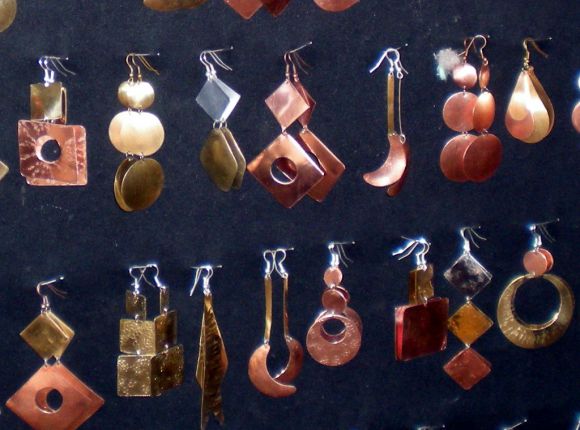
The atomic number for copper is 29, however in Chile, copper is number one. Being the country's major export, copper affects every facet of the Chilean economy. With a long history of mining copper, Chilean craftsmen traditionally have made copper art and jewelry for generations, hence the variety of high quality and affordable copper items, such as rings, wind chimes, necklaces, earrings, murals, coasters, statues, key rings, bracelets and even masks on offer. Prices start at about $2 and upwards, depending on the size and quality of the artwork.
Where to find it:
Simply put, you will find copper everywhere in Chile. My favorite locations to browse are the three major arts and crafts centers is Santiago:Centro Artesanal Los Dominicos, with 180 shops, it is simply the biggest and the best place to shop in Santiago for Chilean crafts
Avenida Apoquindo 9085, Las Condes
Phone: 02-248-2295
Metro station: Los Dominicos
Hours: Monday-Sunday: 10:30am-8pm
Patio Bellavista is a wonderful mix of 20 trendy restaurants and 50 fine crafts shops
Constitución 50, Providencia
Phone: 02-249-8700
Hours: Monday, Tuesday, Sunday: 10am-1am; Wednesday: 10am-2am
Thursday-Saturday: 10am-3am
Centro Artesanal Santa Lucia, is a compilation of 150 fine crafts shops in the center of Santiago, at the foothills of Cerro Santa Lucia
Alameda 510
Phone: 02-632-3668
Metro station: Santa Lucia
Hours: Monday-Friday: 11am-8pm; Saturday: 11am-7pm
8. Mapuche Woven Fabrics
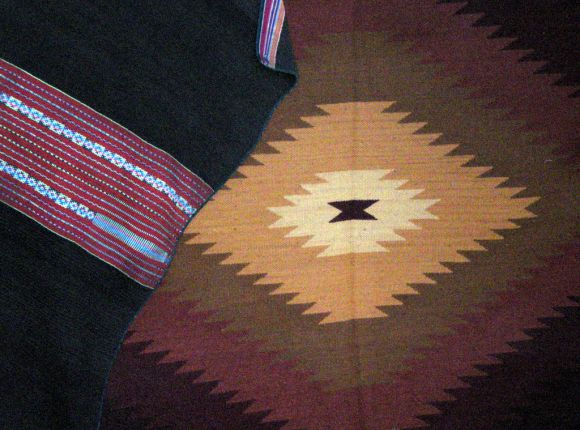
The indigenous Mapuche Indians were nomads who needed quality rugs, ponchos and clothing to face the cold Chilean winters. Renowned for their complex textures and patterns, Mapuche fabrics have been in use since as early as the 1300s. It is even part of the Mapuche tradition to increase the amount of the dowry paid by a man, if a woman was a good weaver. The Mapuche women transmitted their knowledge orally from generation to generation for many years. The colorful designs and symbols found in Mapuche fabrics pay tribute to the culture and traditions of these people. Well designed colorful ponchos and rugs start at $30 USD.
Where to find it:
There are several shops with Mapucho fabrics atCentro Artesanal Los Dominicos
Avenida Apoquindo 9085, Las Condes
Phone: 02-248-2295
Metro station: Los Dominicos
You will also fing Mapucho fabrics at
Feria Artesanal Bellavista
corner of Avenida Bellavista and Pio Nono, next to the river Mapucho
9. Leather Goods

Among the things Chile is famous for, handcrafted leather goods aren't the last. These days, in Santiago it seems like everyone has been wearing leather shoes, judging by the number of shoe shine stands scattered all over the city. This may be unwelcome news for someone with the more traditional views, but leather isn’t just for shoes and wallets anymore. You can find leather wine holders, leather backpacks, leather cooking aprons and even leather coasters. In fact, leather can provide added touch of elegance to anything. Hand-made leather crafts always make for treasured gifts which are both durable and practical. The variety of premium leather items that can be found in Santiago is truly magnificent and includes briefcases, purses, belts, jackets, wallets, computer bags, gloves, hats, pants, even leather jewelry holders. You can find leather at very attractive prices, but bear in mind that prices depend on the quality and size of the leather goods in question. If you want the best price available, get rid of that touristy look on your face and always ask if they can offer a better price.
Where to find it:
Maleteria Evelyn has been fabricating leather goods for 45 years:Av. Manquehue Sur 31, Las Condes
Phone: 777-8207, 737-1204
Opening hours: Monday - Friday: 10am-7pm
A good selection can also be found at:
Artensina en Cuero, Patio Bellavista, Local 45
Providencia
Phone: 762-1122
Hours: Monday, Tuesday, Sunday: 10am-10am; Wednesday: 10am-2am;
Thursday-Saturday: 10am-3am
10. Traditional Masks
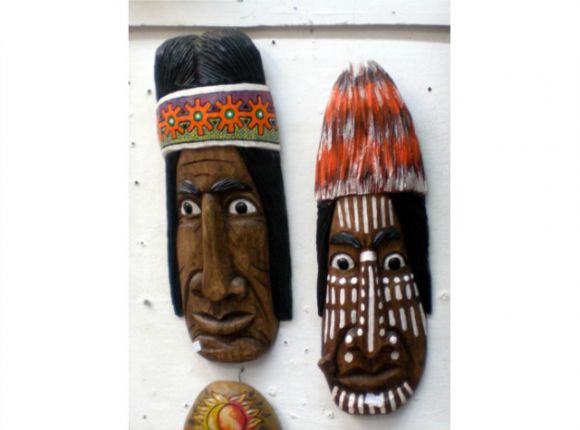
These traditional masks represent the native Ona or Mapucho people who once lived in the southern part of Chile. The Ona people were famous for their black and white body paint and scant clothing. Barefoot, they used to walk among the penguins in Southern America's southernmost tip - the Tierra del Fuego islands, the area in which they settled over 10,000 years ago. Their extinction was caused by western settlement in the late 1800s. Because of their location, the Ona tribe turned out to be the last indigenous people on the American continent to be colonized by Europeans. Detailed accounts of their customs and ceremonies are well documented. The last full-blooded Ona tribe member died in the 1970s. Their traditional masks, usually made out of wood, were used among other items in the ceremony of Nguillatun, the main religious celebration during harvest season, in which the Ona thanked and asked deities for common welfare and prosperity.
Where to find it:
Unique masks can be found at:Centro Artesanal Los Dominicos, local #57
Avenida Apoquindo 9085, Las Condes
Phone: 02-248-2295
Metro station: Los Dominicos
Hours: Tuesday-Sunday: 10:30am-8pm
Don't forget to stop by Local #46 in Centro Artesanal Santa Lucia
Centro Artesanal Santa Lucia, Local #46
Alameda 510
Phone: 02-632-3668
Metro station: Santa Lucia
Hours: Monday-Friday: 11am-8pm; Saturday: 11am-7pm
11. Mapuche Musical Instruments

The Mapuche Indians were such fierce warriors that the Inca Empire, after having conquered all of South America, was eventually defeated by the Mapuche tribes who successfully resisted numerous attempts to occupy their territory. The Mapuche also defeated the Spaniards, who otherwise conquered all of South America, and continued their resistance in southern Chile for about 200 years, until finally signing a peace treaty in the late 1880s. There are two traditional Mapuche musical instuments: the trutruca – a long colorful trumpet with a cow horn for bell; and the kultrún – a leather/wood drum often painted with Mapuche symbols. For either instrument expect to pay between $30 and $60 USD.
Where to find it:
There are two good places to find Mapuche instruments in Santiago:Instrumentos Musicales Mesko
San Francisco 364 - Santiago Centro
Phone: 633-1342
Hours: Monday-Friday: 10am-7pm; Saturday: 10am-2pm
Centro Artesanal Santa Lucia, Local #39
Alameda 510
Phone: 02-632-3668
Metro station: Santa Lucia
Hours: Monday-Friday: 11am-8pm; Saturday: 11am-7pm
12. Pisco
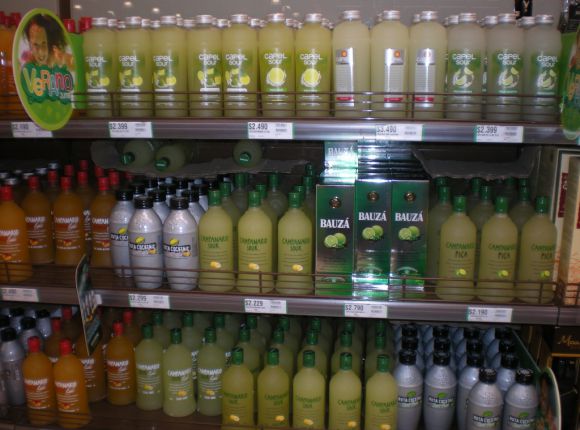
Pisco is a liquor made of grapes. While there is a heated dispute between Chile and Peru as to Pisco origins, drinks made with Pisco are considered an art form in Chile. Pisco is used in various recipes, such as: Pisco Sour, made with lime juice; Mango Sour, made with mango juice; and Sour Haas, made with avocados, pineapple and mint. There is even an Aji Sour, made with Chilean green chili! Pisco comes in varying proofs of alcohol, from 12° to 50°, the higher the proof, the higher the price. You get to decide for yourself if the proof improves the flavor. A nice bottle of Chilean Pisco can range from $5 to $30 USD a bottle. Bottles of premixed Pisco sour and mango sour sell for $6 to $10 USD.
Where to find it:
A very nice selection of Pisco can be found at Larbos:Estado 26, Santiago centro
Hours: Monday-Saturday: 8am-7pm
Club de la union
Avenida Libertado O’Higgins 1091 interior, Santiago centro
Hours: Monday-Friday: 9am-5pm
Also try El Mundo del Viño:
mall Parque Arauco, Local 379
Las Condes
Phone: 02-580-3548
Hours: Monday-Thursday: 10am-8:30pm;
Friday, Saturday: 10am-9pm; Sunday: 11am-8pm
Isidora Goyenechea 2939, Las Condes
Hours: Monday-Friday: 10am-8pm; Saturday: 11am-6pm
13. Chilean Carica

Chilean Carico is also known as Chilean Golden Papaya or Chilean Mountain Papaya, even though it grows near the Atacama Desert (famed as the driest place on Earth). Due to its limited crop size, the exotic Chilean papaya is usually sold and consumed only in Chile. When exported, Chilean papaya is considered a gourmet fruit, used in desserts and garnishing. Unlike other papayas, Chilean Carica is never eaten raw. It should be cooked before eating because of the high level of papain present, an enzyme that digests proteins. This boutique fruit with a bright yellow color and delightful sweet taste is sold in preserves for about $5 to $10 a jar.
Where to find it:
The nice thing about buying this exotic Chilean fruit in Chile is that it is commonly available at all the supermarket chains. You can find them year round at the supermarkets Jumbo, Tottus, Lider, Santa Isabela, or Unimarc. If the supermarket near you is out, then go to the Jumbo at mall Alto Los CondesJumbo, mall Alto Los Condes
Avenida Presidente Kennedy 9001, Las Condes
Hours: Monday-Sunday: 10am-8:30pm
14. Crin

Rari is a small town in southern Chile, near Linares, where the craft of making figures using woven horse hair, called Crin, has originated. This novel form of art has been passed down from mother to daughter for about 300 years. You can find colorful flowers, birds, butterflies, animals, and human figures all made of woven horse hair. These hand-made crafts are still produced one at a time and there are a few shops in Santiago that keep a good stock of Crin items. Of course, if you visit Linares in Southern Chile, it is well worth taking a 21-km trip to Rari. Expect to pay between $5 and 10 USD for a small to medium size Crin figures.
Where to find it:
The one shop that always keeps a nice selection of crin is shop #54 at Centro Artesanal Santa Lucia.Shop #54, Centro Artesanal Santa Lucia
Hours: Monday-Friday: 11am-8pm; Saturday: 11am-7pm
You can also try Patio Bellavista
Patio Bellavista
Constitución 50, Providencia
Phone: 02-249-8700
Hours: Monday, Tuesday, Sunday: 10am-1am;
Wednesday: 10am-2am; Thursday-Saturday: 10am-3am
Get GPSmyCity App for IOS or Android
You can read offline thousands of travel articles like this one in the "GPSmyCity: Walks in 1K+ Cities" app on Apple App Store or Google Play Store. The apps also offer city offline maps and GPS navigation to guide you to the places featured in the articles.
Walking Tours in Santiago, Chile
Create Your Own Walk in Santiago
Creating your own self-guided walk in Santiago is easy and fun. Choose the city attractions that you want to see and a walk route map will be created just for you. You can even set your hotel as the start point of the walk.
Historical Churches and Cathedrals
For a country relatively small in terms of population, Chile is quite rich in two things: coastline and churches. Thanks to the Spanish founders of the Chilean capital, the majority of Santiago’s temples are Catholic. Given that most of them are conveniently located in the downtown area, checking out these historic religious sites doesn’t take too much time.
The San Francisco Church –... view more
Tour Duration: 1 Hour(s)
Travel Distance: 2.4 Km or 1.5 Miles
The San Francisco Church –... view more
Tour Duration: 1 Hour(s)
Travel Distance: 2.4 Km or 1.5 Miles
Bellavista Walking Tour
One of Santiago's most enigmatic neighborhoods, Bellavista is a lively and quirky area akin to Montmartre in Paris. Known for its bohemian culture and thumping nightlife, the district is dotted with casual pubs, low-lit cocktail bars, discos and numerous eateries serving fusion cuisine. Many of the city's esteemed intellectuals and artists live in Bellavista, following in the footsteps... view more
Tour Duration: 2 Hour(s)
Travel Distance: 3.0 Km or 1.9 Miles
Tour Duration: 2 Hour(s)
Travel Distance: 3.0 Km or 1.9 Miles
Santiago Introduction Walking Tour
Santiago is the political, financial, and cultural center of Chile. The capital city was founded on Santa Lucia Hill in 1541 by Spanish conquistador Pedro de Valdivia. Surrounded by the snow-capped Andes, Santiago offers history, gorgeous architecture, world-class museums, and fabulous markets.
Start your trip from Santa Lucia Hill which has one of the best views of Santiago and the Andes... view more
Tour Duration: 2 Hour(s)
Travel Distance: 2.5 Km or 1.6 Miles
Start your trip from Santa Lucia Hill which has one of the best views of Santiago and the Andes... view more
Tour Duration: 2 Hour(s)
Travel Distance: 2.5 Km or 1.6 Miles






